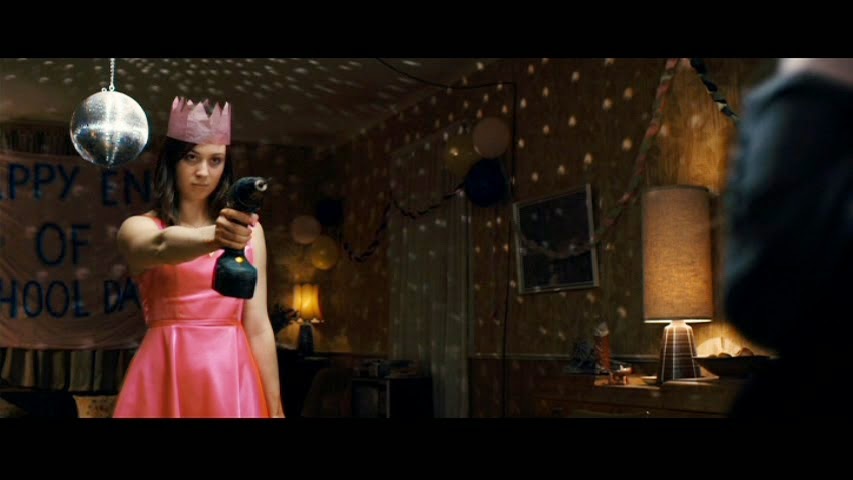Happy Halloween! The countdown is over and Halloween is finally upon us. Tonight, hopefully, you'll be relaxing, eating some candy, and watching a scary, or not-so-scary, movie. There are a lot of options for tonight and I hope I've been of some help. Here is my final recommendation to help bring an end to Shocktober:
Night 13: Matinee
Theater Manager: “The country is on red alert. People are already scared.”
Lawrence Woolsey: “Exactly! What a perfect time to open a
new horror movie.”
Matinee, directed by Joe Dante begins with real images of actual horrors: stock footage of nuclear blasts annihilating a house, bending and breaking trees. This is what was on the minds of Americans in October of 1962 during the Cuban missile crisis, especially those in Key West, Florida where Matinee takes place. Film producer and showman Lawrence Woolsey comes into town to test screen his latest movie, MANT, a cheesy B-horror movie about a man turning into a radioactive ant monster. Woolsey thinks the atmosphere of nuclear hysteria that the town is feeling is perfect for the premiere of his film. He needs it to be a big success to impress a big time theater owner and get nationwide bookings. Luckily, Woolsey has a few tricks up his sleeve.
The other main character is a young teenager named Gene
Loomis. His family just moved to Key West because his father is in the Navy and is
serving on one of ships surrounding Cuba. Gene and his little
brother, Dennis, spend their free time at the local movie theater
watching low budget horror movies. When another boy that lives on naval base asks if they want to shoot frogs with an air gun, Dennis is
excited until Gene politely tells the boy no and whispers to Dennis, “that’s
disgusting.” Dennis immediately agrees. These boys only like horror and
death when it is fake and on a screen.
The boys are both big fans of Woolsey and get to meet him outside of
the movie theater when Woolsey shows up to address some men protesting his
upcoming movie. Gene recognizes one of the protesters from Woolsey’s previous
movie and realizes the protest is staged. When he brings it up to Woolsey in a later scene, Woolsey is
impressed and befriends Gene. As they walk around town Woolsey talks to Gene
about the appeal of horror and monster movies. He tells him that people that put
their hands over their eyes for the scary parts aren’t getting the full
experience of the movie. When the scare is over you feel safe and alive, you know you are alive. That’s what horror
movies are all about.
Matinee is inspired by horror movie
producer/director/promoter William Castle and the kitschy, but loveable, movies
he made in the 1950s and 60s. John Goodman is great as the kid-at-heart Lawrence
Woolsey, who is based directly on Castle. The first time we see Woolsey is in a
trailer for his upcoming movie. He is in a pose recreating William Castle's famous
silhouette (the second most famous silhouette in movies): sitting in a
director’s chair with a cigar and looking up. Castle’s films succeeded largely
because of the gimmicks he used to enhance the viewing experience and scare
the audience. Perhaps his most famous gimmick is from The Tingler starring
Vincent Price. Certain theater seats were rigged with buzzers to
give the moviegoers in those seats a jolt, at just the right moment, and scare them out of their seats.
Woolsey uses the same effect for MANT, along with a few others. He also hires
someone to run out into the audience in an ant suit during certain scenes and
requires everyone seeing MANT to sign a waiver in case they are scared to death
(another gimmick Castle used for one of his movies).
The screening for MANT is the climax of Matinee and is over
the top, to say the least. It’s the kind of showing that William Castle would’ve
dreamed of having. However, the real heart of the climax is what is happening
between Gene, his friend Stan, and their respective dates. Matinee does a great
job of showing us the romanticized version of life in the early 1960s, but
also the real fears and dangers of the era. The kids are just as worried about
nuclear war as the adults, but they also have average teenage worries that keep
them from slipping into hysteria.
Matinee is not just a movie about
movies, a genre I happen to love, it is about moviegoers and storytellers. It
is about how movies can be a type of catharsis and help us escape from reality,
even if that reality is impending nuclear war. It is a rare love letter to
horror movies and why we go to them, even bad ones. It does its best to try to
show us the intangible experience of going to the movies. William Castle did
his best to give his audiences a true and memorable experience and Matinee is a
fitting and loving tribute to him and his movies.



-large-picture.jpg)













































